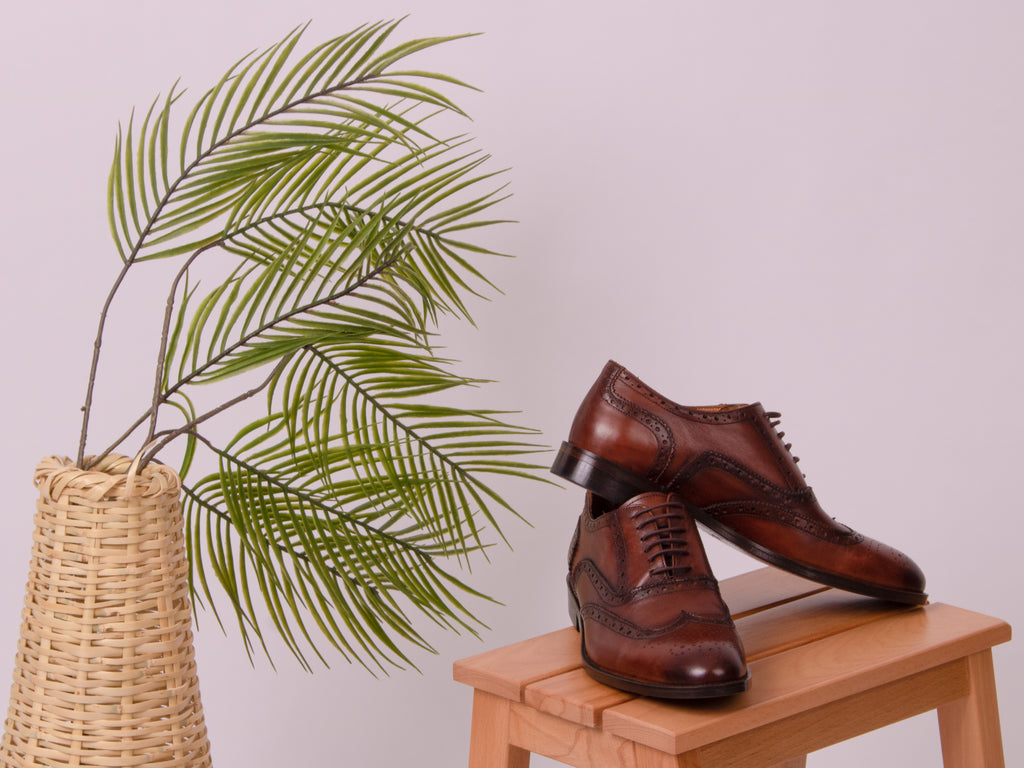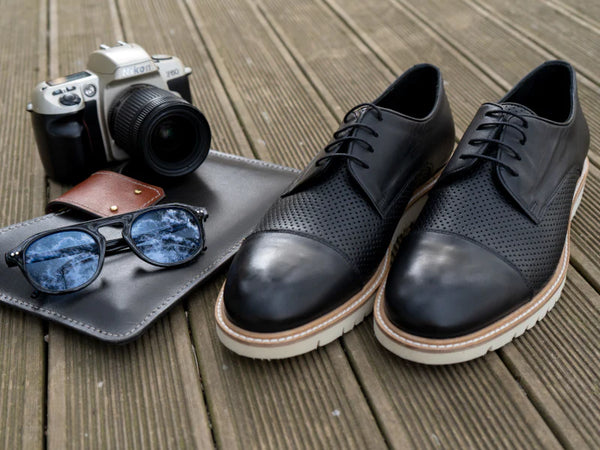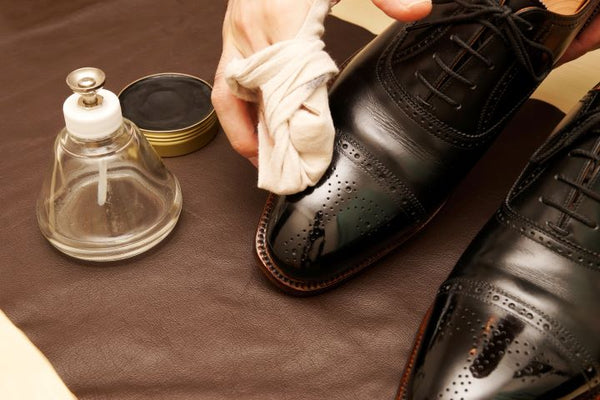Winged Tip Dress Shoes: From Function to Fashion
Written By SHILOH BECKETT •

- What is Wingtip or Winged Tip Dress Shoes?
- History
- Types Of Winged Tip Dress Shoes
- Winged Tip Dress Shoes and Formality
- Closing Fun Facts and Know-It-All Comments
Today, we'd like to introduce you to the Wingtip or Winged Tip dress Shoes, a design that undoubtedly catches the eye of anyone newly interested in men's dress shoes. When you step into any store, it's often the first shoe that draws your attention and, invariably, one of the ones that staff will eagerly point out and hand to you.
With a fascinating origin story, winged tip dress shoes have now become a staple shoe design in the wardrobe of almost every modern man who values his appearance and possesses a keen sense of time and place. However, it's worth noting that, in the realm of classic men's dress shoes, there's a plethora of commonly held misconceptions. Just as we highlighted in our discussion on "Oxford Not Brogues," it's essential to point out a similarly significant misconception -although not as serious as mislabeling Derby shoes as Oxford Derby shoes?!, that exists between winged tip dress shoes and brogues. 😊 I think after this introduction, we can proceed further.
What is Wingtip or Winged Tip Dress Shoes?
Simply put, Winged Tip Dress Shoes are men's dress shoes characterized by a toe design that, depending on your viewpoint, looks like a 'W' or 'M'. As the name suggests, wingtip dress shoes have a design that extends from the toe of the shoe outward, resembling a bird's wing. They're often associated with the brogue family. While traditionally and most commonly applied to brogue-styled shoes because of their origin, this is not technically a 100% accurate description today. Among the vast variety of styles, there are designs that fit our winged tip description but lack the brogue perforations, meaning they're not brogues. Thus, when we speak of a traditional wingtip dress shoe, yes, brogues are the first thing that comes to mind, but we should keep in mind that there are winged tip designs without brogue details. Additionally, one can say that traditional wingtip dress shoes are considered less formal than plain or cap toes, primarily because the punched perforations and multiple layers of leather give them a less sleek silhouette.
The Intriguing Historical Journey of Winged Tip Dress Shoes
We dropped some hints in the introduction: Wingtip or Winged Tip Dress Shoes arose from necessities and practical needs. The most accepted version of the story suggests that the rainy climate and wet grounds of Scotland and Ireland, along with the muddy and sinking marshlands, inspired the creation of perforations in shoes, which later evolved into what we recognize as brogues. This was done to traverse such terrains more comfortably and allow wet shoes to dry faster. Some sources also link this design to the hunting and shooting traditions of 16th-century Ireland and Scotland. The term 'brogue' is believed to have been derived from the Gaelic word 'brog', meaning shoe.

Early Years of Winged Tip Dress Shoes: Good Old Days 😌
By the end of the 19th century and the beginning of the 20th, shoes that once had a country character due to practical necessities started transforming into a form of art and aesthetic. Legend has it that in the early 20th century, the Prince of Wales donning a two-toned winged tip dress shoes, known as the spectators shoe, during a golf event started their rise in popularity. Their prominence grew even further when screen phenomena, like Fred Astaire and Gene Kelly incorporated them into their musicals and tap dancing performances. The adoption of winged tip dress shoes by phenomenal figures like Elvis Presley solidified their position as a staple in fashion.
Astaire and Kelly influenced fashion trends of their era, including the popularity of wingtip dress shoes
Types Of Winged Tip Dress Shoes
Full Brogue Wingtip Dress Shoes
The design features wingtips that expand from the toecap, with decorative perforations atop the toecap, along the seams, and frequently on the wing's body. t's the most traditional form of wingtip. So much so that sometimes 'full brogue' and 'wingtip' are used interchangeably.
Longwing Winged Tip Dress Shoes
Like other wingtips, longwings have the characteristic "W" or "M" shape on the toe. What sets longwings apart is the extension of this wingtip feature. The "wings" of the longwings extend all the way to the back of the shoe, meeting at the center seam at the heel. This is different from regular wingtips, where the wings typically only extend to the midsection of the shoe. They might be designed with or without brogues.
Longwing Tassel Loafers by Debbano
No Brogues Wingtips
They are shoes that reflect the wing-shaped general characteristic but lack Brogue-style perforations. Hence, they are considered more formal
A Blind Brogue Wingtip Derby by Debbano
Spectator Shoes
Spectator shoes are easily recognized by their two-tone design, where the toe and heel cap contrast with the shoe's main body in color or material. Often styled as winged tip dress shoes, they gained popularity through their association with performers like Fred Astaire.

Ghillie Brogues
Ghillie brogues are traditional Scottish shoes distinguished by their lack of a tongue, decorative perforations, and long laces that wrap around the ankle and lower calf. Originally crafted for traversing wet Scottish landscapes, they're now commonly paired with kilts for formal occasions. Moreover, these shoes predominantly adopt the wingtip style.

Scottish Ghillie
Winged Tip Dress Shoes and Formality
A useful rule of thumb in dress shoe etiquette is that the more embellishments, intricate details, and layers of leather a shoe features, the less formal it tends to be. For winged tip dress shoes specifically, the extent of the winged design is often inversely proportional to its formality. Wingtips were initially pigeonholed as a country style, and due to their brogue accents and wing-shaped toes, they have been perceived as more casual. However, this doesn't suggest they pair well with casual shorts within their conservative stylings. Moreover, it's crucial not to adhere too strictly to this categorization. Historically, the design's usage shifted from casual settings to more formal ones. A testament to evolving fashion norms is that shoes with extensive broguing were once seen as less formal because of their outdoor roots. Today, the degree of broguing is more about personal preference than formality. So, while we can draw broad conclusions, any final analysis should specify which wingtip style is under discussion.
Some Closing Fun Facts and Know-It-All Comments 😉 Regarding Winged Tip Dress Shoes
- The term "wingtip" or "winged tip" doesn't refer to mainstream dress shoe categories like Oxford, Derby, Monk, Loafer, or Dress Sneaker. It's a specific design name. Although "brogue" is interchangeably used due to its origin and popularity, any Oxford, Derby, Monk, Loafer, or even Dress Sneakers can be a wingtip and may or may not have brogue perforations.
- To those sellers who label every dress shoes besides dress sneakers as an Oxford: please stop! 📢
- Fashion experts who introduce semi brogues and quarter brogues within wingtips please reconsider🙏. It's confusing.
- Wingtips were predominantly men's shoes until the 1920s when women began wearing them as a rebellious statement against gender norms. Now, many brands produce women's wingtips.
- Recent period movies and TV shows highlighting vintage fashion have revived the wingtip's popularity.
- Once viewed as informal and inappropriate for some conservative business settings, the perception of wingtips has evolved over time.
- Each full brogue's perforations were once handcrafted, giving every pair a unique touch.
- In the 20th century, certain Ivy League school students wore winged tip dress shoes as pride and status symbols. The wear and tear on their wingtips often represented their college life's progression.
Follow Us
Inspired by its native soil in Europe, where not only the continents but also many magnificent civilizations meet, Debbano gathers peerless sophistication, beauty, artistry, and, ultimately, the gloriousness of the best quality leather with its unique patterns and identity.
Follow us to be updated about style, colors, materials and construction techniques, fashion, lifestyle, and much more, including winged tip dress shoes. You can visit our website and/or follow our Instagram and YouTube channels.






